Formulating challenge: Creating better epoxies for vacuum-infused aerospace parts
More attention is being focused on fabricating processes for aircraft structures that can save time and money and improve efficiency while yielding high-quality parts. Historically, nearly all aircraft designers have assumed autoclave cure as the norm, despite the well-documented cost and time advantages of
More attention is being focused on fabricating processes for aircraft structures that can save time and money and improve efficiency while yielding high-quality parts. Historically, nearly all aircraft designers have assumed autoclave cure as the norm, despite the well-documented cost and time advantages of out-of-autoclave processing. The formulation of epoxy-based resin systems that can be used to vacuum infuse dry fibers or preforms holds great promise for producing large, complex composite parts with less than 1 percent void content and controllable resin/fiber ratio. Vacuum infusion permits the use of inexpensive “soft” tooling and ambient/near-ambient curing to reduce autoclave processing costs and save energy.
A key to formulating one- and two-part epoxy resin systems for aerospace vacuum infusion is balancing viscosity with in-service performance. Huntsman Advanced Materials (The Woodlands, Texas), a pioneer with its trademarked RenInfusion epoxies for infusion processes, has found that through the use of nano-based toughening agents, new-generation infusion epoxies can be produced with physical property combinations that once were apparently diametrically opposed. For example, epoxy formulations have been developed that can be infused at temperatures less than 120ºF (49ºC) for two-part systems, and 180ºF (83ºC) for one-part systems, says Huntsman senior chemist Jim Hoge, delivering adequate pot life, a high glass transition temperature (Tg), and good toughness with high modulus. System dry Tg’s are in the 280ºF to 350ºF (138ºC to 177ºC) range.
Hoge researched nano toughening agents, including rubber core-shell copolymers, silicon dioxide, clays and carbon nanotubes (all characterized as having particle sizes of less than 100 nm in diameter), testing their ability to enhance physical part properties without significantly affecting system viscosity. Individually, or in combination, nanomaterials can improve toughness related to impact, fracture and fatigue to help meet aerospace performance specifications. The products also can increase modulus, reduce coefficient of thermal expansion (CTE) and shrinkage, and minimize stress induced during cure.
To develop new infusion epoxies, Huntsman began by preparing a list of optimal handling properties. The ideal viscosity for infusion of structural aircraft parts was determined to be less than 500 centipoise (cps) at room temperature if possible. A minimum working life of 1.5 hrs at infusion temperature/viscosity was selected to accommodate the infusion of large parts. Starting with existing one-part and two-part RenInfusion epoxy systems, the objective was to obtain fracture toughness values of more than 0.9 MPa with tensile modulus greater than 3,100 MPa.
Neat resin samples also were tested to determine the ability of the new-generation, nano-enhanced epoxy infusion systems to resist moisture absorption and thereby maintain good properties in a hot-wet environment. The goal was to maintain a neat Tg of at least 130ºC (266ºF) after conditioning samples for 14 days at 71ºC (160ºF). Cured neat epoxy samples also were studied after heat aging in an oven for 200 hours at 149°C (300°F) and 400 hours at 177°C (350°F) to determine the effect of various nano-tougheners, liquid rubbers, and reactive plasticizers on the thermooxidative resistance of one- and two-part candidate systems.
As expected, two-part epoxy/anhydride systems maintained the highest Tg after heat aging in the 350°F heat age range. These systems do, however, have several disadvantages compared to epoxy/amine two-part systems, including the need for more time and higher temperature for initial setup, initial cure, and full postcure property build. Poor moisture resistance and brittleness also can develop.
Also, as expected, aromatic amine curatives produced better thermoxidative resistance than cycloaliphatic amine curatives. All epoxy/amine systems studied with initial cured Tgs of more than 200°C (392ºF) showed substantial Tg drops when heat-aged for 200 hours at more than 185°C (365°F). The epoxy/anhydride cured systems showed no drop or had actual gains in Tg.
Further study is underway, including development of correlations between neat and infused composite properties, e.g., the wetting ability and the bond strength between the epoxy matrix and the fiber. Says Hoge: “Our work demonstrates that processing characteristics can be improved with minimal sacrifice to mechanical properties and with added toughening effects. The goal is to produce systems with equal or improved mechanical performance, laminate quality, and damage tolerance in comparison to the current autoclave processed systems for aerospace.” Hot/wet properties, thermal oxidative properties, and toughness relating to microcrack prevention during thermal cycling are being enhanced.
Related Content
Busch expands autoclave solutions
Busch announces its ability to address all autoclave, oven and associated composites manufacturing requirements following the acquisition of Vacuum Furnace Engineering.
Read MoreVIDEO: One-Piece, OOA Infusion for Aerospace Composites
Tier-1 aerostructures manufacturer Spirit AeroSystems developed an out-of-autoclave (OOA), one-shot resin infusion process to reduce weight, labor and fasteners for a multi-spar aircraft torque box.
Read MorePlataine unveils AI-based autoclave scheduling optimization tool
The Autoclave Scheduler is designed to increase autoclave throughput, save operational costs and energy, and contribute to sustainable composite manufacturing.
Read MorePlant tour: Airbus, Illescas, Spain
Airbus’ Illescas facility, featuring highly automated composites processes for the A350 lower wing cover and one-piece Section 19 fuselage barrels, works toward production ramp-ups and next-generation aircraft.
Read MoreRead Next
VIDEO: High-volume processing for fiberglass components
Cannon Ergos, a company specializing in high-ton presses and equipment for composites fabrication and plastics processing, displayed automotive and industrial components at CAMX 2024.
Read MoreAll-recycled, needle-punched nonwoven CFRP slashes carbon footprint of Formula 2 seat
Dallara and Tenowo collaborate to produce a race-ready Formula 2 seat using recycled carbon fiber, reducing CO2 emissions by 97.5% compared to virgin materials.
Read MoreDeveloping bonded composite repair for ships, offshore units
Bureau Veritas and industry partners issue guidelines and pave the way for certification via StrengthBond Offshore project.
Read More





















